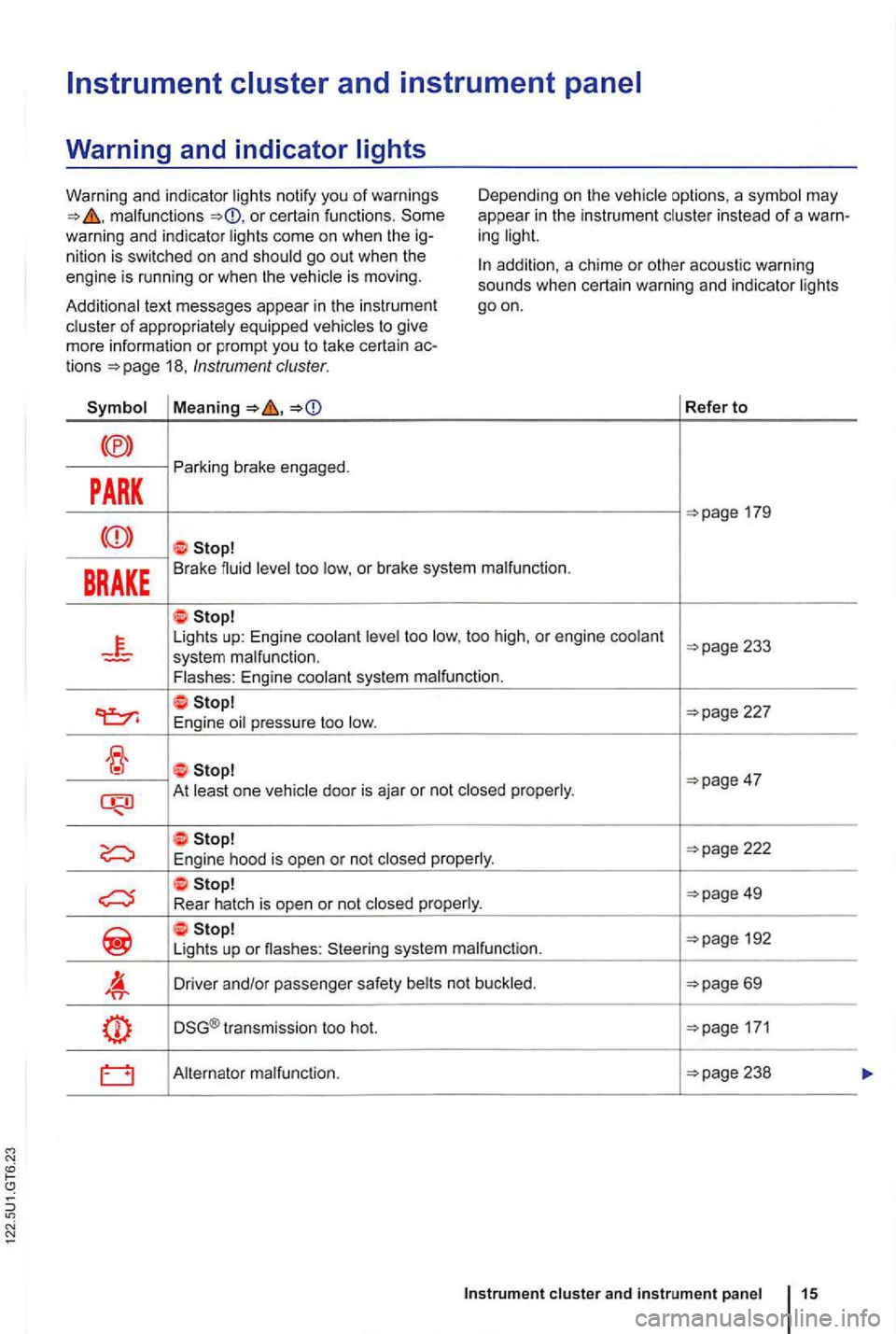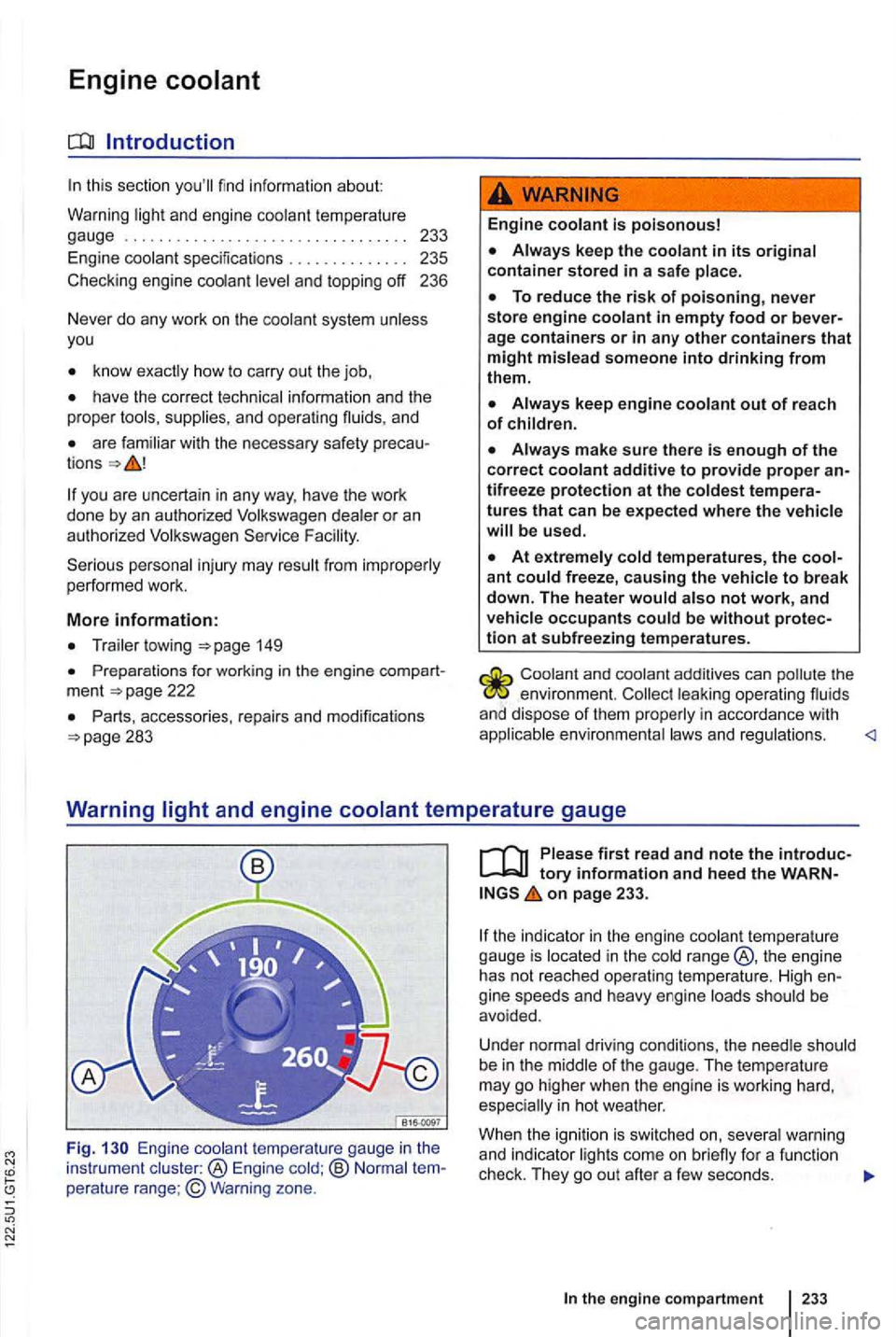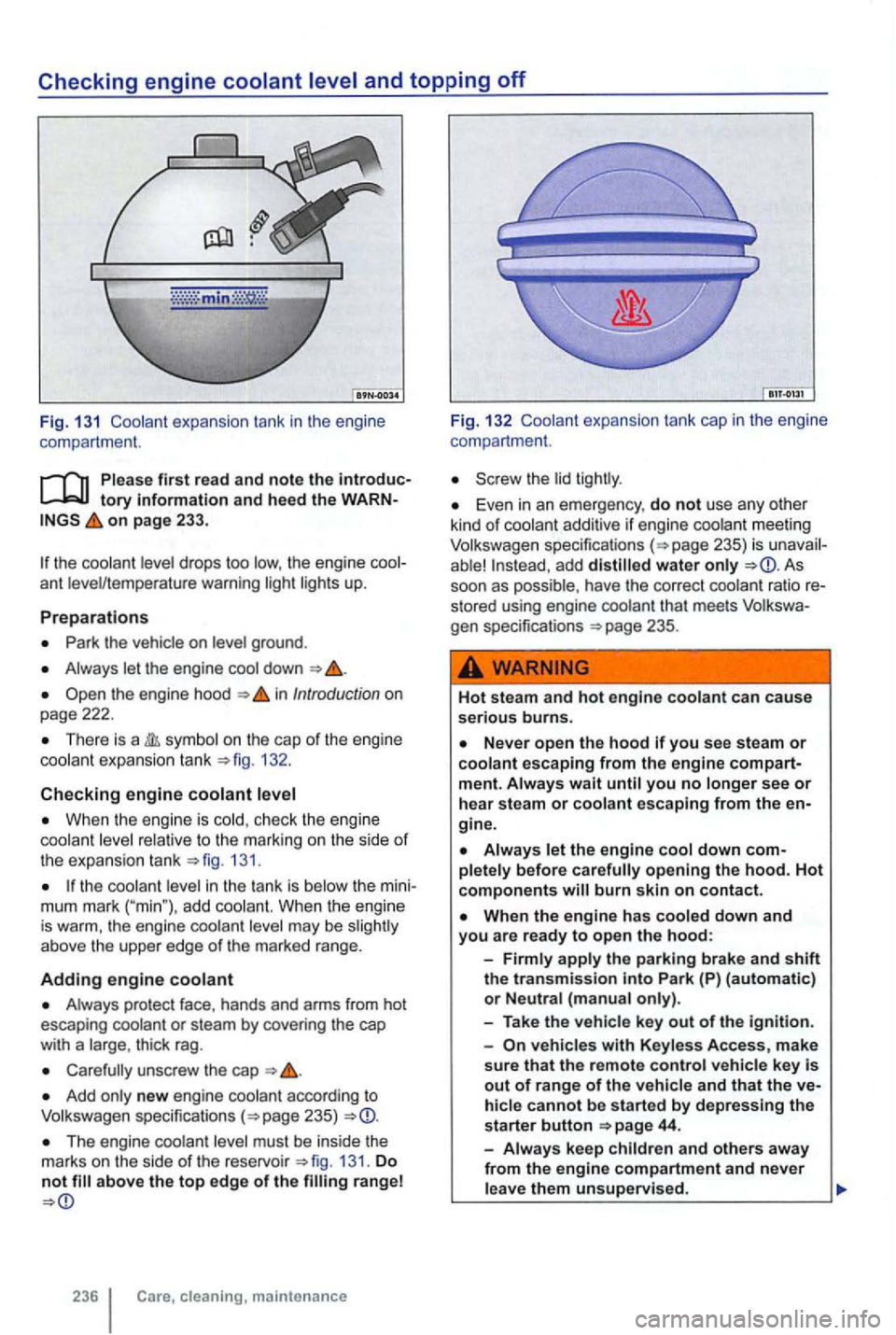Page 114 of 516

malfunctions or certain functions . Some
warning and indicator ligh ts come on when the ig
nition is swi tched on and shou ld go out when the
engine is running or when the vehicle is moving. D
epending on the vehicle options, a symbol may
appea r
in the instrum en t cluster in stead of a warn
ing light.
Additional text messages appear in th e instrumen t
cluster
of appropriately equipped vehicles to give
mo re information or prompt you to take certain actions 18, Instrument cluster.
addition, a chime or other acoustic warning
sounds when certain warning and indicator lights
goon.
Refer to
PARK
Parking brake engaged.
BRAKE Brake fluid level too low, o r brake system malfunction .
Lights up: Engine coolant level too low, too high , or engine coolant
227
E ngine oil pressure too low.
At least one vehicle door is aja r or not closed properly .
192
Li gh ts up or nashes : Steering system malfunction.
Driver and/or passenger safety belts not buckled .
DSG® transmission too hot. 171
Alternator malfunction.
cluster and instrument panel 15
Page 321 of 516

Care,
this sect ion
know how to carry out the
have the correc t technical information and the
proper too ls and supplies, and
are fami liar with the necessary safety precau
t ions
you are uncertain in any
Fa cility. from improperly per
formed work.
More
Exterior views
Windshie ld wipe r and was he r 129
S tart ing and stoppi ng t he engi ne
Brake fluid 179
Vehicle battery
E ngine oil 227
Engin e coolant 233
Parts, accesso ries, repairs and modifications 283
Unintend ed vehicle movement during maintenanc e work can ca use serious personal injuries.
Care , cleaning, maintenance
Never work under the vehicle unless you have safely secured the vehicle from moving. you mus t work under the vehicle with the
wheels on the g round , alway s make sure that the vehicle is on level ground, that
Th e engine compartment of any motor vehicle is a potent ially dangerous area and can cause serious personal injury.
Always use extreme caution when doing any work
Never p erform any work in the engine compartment unless you know exactly how to carry out the job and have the correct tec hnical information and the correct tools .
you are uncertain about what to do, have the work performed by an authorized
Volk swagen dealer, an authorized Volksw a
ge n Service Facility, or another qualified workshop. Serio us persona l injury may result from improperly performed work.
Page 332 of 516

Engine
this section you'll find information about
Warning light and en gine coolant tempe rature
gaug e ................................. 233
En gine coolant spec ifica tions . . . . . . . . . . . . . . 235
Checking engine coolan t level and toppi ng
o ff 236
Ne ver do any work
on the coolant system unle ss
you
know exactly how to carry out the job,
have the correct technical inform ation and the
proper tools, supplie s, and operating fluids, and
are fa miliar with the necessary safety
you are uncertain in any way, have the work
done by an authori zed Volkswage n dea le r or an
a uth orized Volkswagen
in jury may
to wing =>page 149
Preparat ions for work ing in the engi ne page 222
Parts, accesso ries, repai rs and modifications =>page 283
Engine coolant is poisonous!
To reduce the risk of poisoning, never
store engine coolant in empty food or age containers or in any other containers that might mislead someone into drinking from them.
Always make sure there is enough of the correct coolant additive to provide proper tifreeze protection at the coldest tures that can be expe cted where the vehicle will be used .
At extremely cold temperatures, the ant could freeze, causing the vehicle to break down. The heater would also not work, and
vehi cle occupants could be without
Coolant and coolant additives can po llute the en vironme nt. leaking ope rati ng fluids
a nd dis pose of them properly in acco rdance with
applicab le environment al
Warning light and engine coolant temperature gauge
Fig.
perature range;© Warning zone.
first read and note the
on page 233.
the in dicator in the engine coolant tempera ture
gauge is located in the cold range @, the engine
h as not reached operating temperature . H igh
gi ne s peeds and heavy engine loads should be
avo ided .
Under normal driving con
ditions , the needle should
be in the middle of the gauge . The tempe ratu re
may go higher when the engine is working hard, espec ially i n h ot weather.
When
the ign ition is switched on, seve ra l warn ing and indicato r
the engine compartment 233
Page 335 of 516

Checking engine coolant level and topping off
Fig. 13 1 Coolant expan sion tank in the engi ne
compartme nt.
Please first read and note the introductory Information and heed the WARN on page 233.
Park the vehicle on level ground .
Always let the engine down
the engine hood in Introduction on
page 222.
There is a sy mbol on the cap of the engine coolant expans ion tank 132 .
Checking engine coolant
When the engine is cold , check the engine
coolant level relative to the marking on the side of the expansion tank 13 1.
the coolant level in the tank is below the mini
mum mark ("min"), add coolant. When th e engi ne is warm, the engine coolant level may be slig htly
above the upper edge of the marked range.
Adding engine coolant
Always protect face, hands and arms from hot
escaping coolant or steam by covering the cap
with a large , thick rag.
Carefully unscrew the cap
Add only new engine coolant according to
The engine coolant level must be inside the
marks on the side of the reservoir 131. Do not
236 cleaning, maintenance Fig.
132 Coola nt expansion tank cap in the eng ine
compa rtment.
Screw the lid tightly .
Even in an emergency , do not use any other kind of coolant additive if engine coolant meeting
add distilled water only As
soon as possible , have the correct coolant ratio re
sto red using engine coolant that meet s
WARNING
Hot steam and hot engine coolant can cau se serious burns.
Neve r open the hood you see steam or coolant escaping from the engine compartment. Always w ai t until you no longer see or hea r steam or co olant escaping from the en
gine .
opening the hood. Hot components will burn skin on contact.
Park (P) (automatic) or Neutral (manua l only).
- Take the vehicle key
out of the ignition.
-
veh icles with Keyless Access, make
sure that the remote control vehicle key is out of range of the vehicle and that the vehicle cannot be sta rted by depressing the
starte r button 44.
-
Always keep children and others away
from the engine compartment and never
l eave them unsupervised.